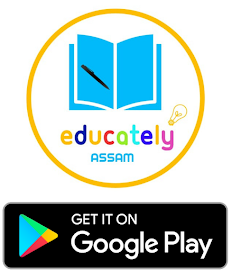Chandraprabha Saikiani all questions and answers class 8 | SCERT | ASSAM
Sunbeam English Reader Class 8 Chapter 8 Chandraprabha Saikiani all questions answers
1. Answer the following questions from the lesson to check your comprehension:
(a) Who was Chandraprabha Saikiani?
Answer: Chandraprabha Saikiani was a renowned social reformer from Assam who fought to make formal education available for girls.She fought when society did not allow girls to step out of home.
(b) What did Chandraprabha do to educate the girls of her village?
Answer: During the time when society did not allow girls to step out of home, Chandraprabha realised that girls had to fight a hard battle to receive an education as good as that received by boys. So, after school, she would gather other girls and teach them what she had learnt during the day. In this way she educated the girls of her village.
(c) Which two incidents show us how Chandraprabha fought for the rights of girls?
Answer: The two incidents which show us that how she fought for the rights of girls are as follows :
(i) In those days girls weren’t admitted into the hostel unless they converted to Christianity. Chandraprabha vehemently opposed this and the school authorities were compelled to allow girls of all religions to avail the hostel facilities.
(ii) Chandraprabha saikiani in the year 1925 challenged the prevailing custom of women sitting behind a bamboo screen in public meetings.
(d) On what occasion did Chandraprabha Saikiani inspire women to come out from behind the bamboo screen?
Answer: Chandraprabha Saikiani Inspired women in the year 1925 to come out from behind the bamboo screen, when she vehemently opposed the prevailing custom of women sitting behind a bamboo screen in public meetings. In the Assam Sahitya Sabha held in that same year she delivered a very powerful speech and demanded the removal of the bamboo screen that was placed between men and women.
(e) What steps did Chandraprabha take to eliminate the caste system?
Answer: Chandraprabha Saikiani was greatly affected by the deep rooted caste system in India. In Assam, she took matters into her own hands. She eliminated the caste system by taking radical steps. She fought for the entry of everyone, irrespective of caste, gender and class, into the famous Hayagriva Madhava temple at Hajo.
(f) What was Chandraprabha Saikiani's role in the freedom movement of India?
Answer: Chandraprabha Saikiani was inspired by Mahatma Gandhi to join the freedom movement. From 1930 onwards she immersed herself in the freedom movement. She spread the message of Khadi, boycott of foreign clothes, removal of untouchability, banning of opium and other social evils. She was imprisoned thrice but nothing could dampen her indomitable patriotic spirit. Whenever she saw any injustice, her rebellious spirit rose to the occasion.
Sunbeam English Reader Class 8 Chapter 8
2. Work in pairs and complete the following sentences with information from the lesson:
(a) At a time when society did not allow young girls to step out of home, she fought to make formal education available for girls.
(b) In those days girls' school did not exist, so Chandraprabha and her sister did not mind wading through mud to attend a school which only had boys.
(c) Chandraprabha and her sister were awarded a scholarship to study in Nagaon Mission school.
(d) In order to eliminate the evils of the caste system, Chandraprabha fought for the entry of everyone irrespective of caste, gender, and class, into the famous Hayagriva Madhava Temple at Hajo.
(e) Being inspired by Mahatma Gandhi, Chandraprabha also joined the freedom movement and spread the message of khadi and several other things for the cause of the movement.
3. Read the following sentences and find a word from the text to replace the underlined part.
(a) Chandraprabha Saikiani was a renowned social worker from Assam.(famous and respected).
(b) She tried to get rid of all the taboos against women that prevailed during those days.(cultural or religious restrictions)
(c) Chandraprabha Challenged the prevailing custom of women sitting behind bamboo screens in public meetings.(refused to accept and questioned)
(d) She was Staunchy against society's restriction and her protest against the norms of society was not confined to a particular incident.(strong in her attitude)
(e) Whenever she saw any injustice, Rebellious spirit rose to the occasion.(her desire to resist authority).
4. Listen to your teacher read out the first paragraph of the lesson. As you listen, complete the table below with information about Chandraprabha Saikiani:
(a) Chandraprabha Saikiani: A Renowned social reformer from Assam.
(b) Birth : 16 March 1901
(c) Father: Ratiram Mazumdar.
(d) Mother: Gangapriya.
(e) Sister: Rajaniprabha
(f) School: A School which only had boys.
5. There are seven paragraphs in the lesson Chandraprabha Saikiani. Choose the appropriate description for each paragraph.
(a) The first paragraph is about:
(i) Chandraprabha Saikiani's childhood
(ii) Chandraprabha Saikiani's birth as a social reformer
(iii) Chandraprabha Saikiani's career as a school teacher
Answer: (ii)Chandraprabha Saikiani's birth as a social reformer
(b) The second paragraph is about
(i) Chandraprabha Saikiani's preparation to be a school teacher
(ii) Girl's education vs boy's education
(iii) Chandraprabha Saikiani's efforts to get an education just like the boys of her village
Answer: (ii) Girl's education vs boy's education
(c) The third paragraph is about:
(i) her fight for freedom
(ii) her fight for the rights of girls
(iii) her fight against British rule
Answer: (ii) her fight for the rights of girls
(d) The fourth paragraph is about
(i) formation of Assam Pradeshik Mahila Samiti
(ii) Chandraprabha Saikiani's protest against restrictions imposed on women
(iii) Chandraprabha Saikiani's speech at the Assam Sahitya Sabha meeting
Answer: All of the above
(e) The fifth paragraph is about:
(i) the caste system of India
(ii) Chandraprabha Saikiani's visit to Hajo
(iii) Chandraprabha Saikiani's protest against the caste system
Answer: (i) the caste system of India, and (iii) Chandraprabha Saikiani's protest against the caste system.
(f) The sixth paragraph is about:
(i) Chandraprabha Saikiani's meeting with Mahatma Gandhi
(ii) Chandraprabha Saikiani as the freedom fighter
(iii) the punishment Chandraprabha Saikiani received for being a freedom fighter
Answer: All of the above
(g) The seventh paragraph is about:
(i) Chandraprabha Saikiani's rebellious spirit
(ii) Chandraprabha Saikiani's imprisonment
(iii) Chandraprabha Saikiani's motivation to join the freedom movement
Answer: None of the above
6. Discuss in groups and share what you have learnt:
(a) The condition of women during the days of Chandraprabha Saikiani
Answer: During the days of Chandraprabha Saikiani society did not allow girls to step out of home. She and her sister Rajaniprabha were so eager to study that they had to attend a school which only had boys and it was situated several kilometers away.During that time the girls had to fight a hard battle to receive an education as good as that received by boys.In those days the girls were not admitted into the hostel unless they converted to Christianity.
(b) Chandraprabha Saikiani’s role in the freedom movement.
Answers: Check answer no.(f) of Q.1
7. Let’s learn some grammar:
In this lesson you have come across verbs that use ‘to’ before them-
(a) She was inspired to join in the freedom movement.
The form “to join” is a non-finite verb generally known as the to-infinitive.
The to-infinitive can also be used as the subject of a sentence as in-
(b) To keep the guests waiting is not good.
It can also be used as the complement of a sentence-
(d) It is not good to keep the guest waiting.
Now practise using the to-infinitive.
Combine these sentences by using to-infinitives. The first one is done for you-
(a) I will visit the book fair. I will buy a few novels.
I will visit the book fair to buy a few novels.
(b) We are going to puri tomorrow. We will visit the Jagannath Temple there.
We are going to puri tomorrow to visit the Jagannath temple there.
(c) She started a small school for girls. She would help them to overcome the taboo against women.
She started a small school for girls to help them overcome the taboo against women.
(d) She delivered very powerful speech. She demanded the removal of the prevailing customs of women sitting behind between bamboo screens.
She delivered very powerful speech to remove the prevailing customs of women sitting behind between bamboo screens.
(e) She and her sister were awarded a scholarship. They will study in Nagaon Mission School.
8. You must have come across English words which have different forms. One word can be used to form several other words, and such words usually go to a different word class. For example, Look at the following word web where you will see different forms of the word beauty.
9.(a) Have you ever read of CEDAW? The full form of CEDAW is the Convention of elimination of all forms of Discrimination against Women. CEDAW is an international treaty adopted in 1979 by the United Nations General Assembly. Described as an internal bill of rights for women, CEDAW was ratified by 189 countries. Some of the important features of CEDAW are:
- Government shall take concrete steps to eliminate discrimination against women
- Governments shall take all appropriate measures to ensure that women can enjoy basic human rights and fundamental freedoms
- Governments shall take appropriate measures to eliminate sexist stereotypes.
- Women will have the right of vote, to participate in forming and implementing government policies.
- Women will have the right to represent the country at an international level.
-Women and girls should receive career and vocational guidance and have acces to education opportunities at par with men or boys.

.png)





No comments:
Post a Comment